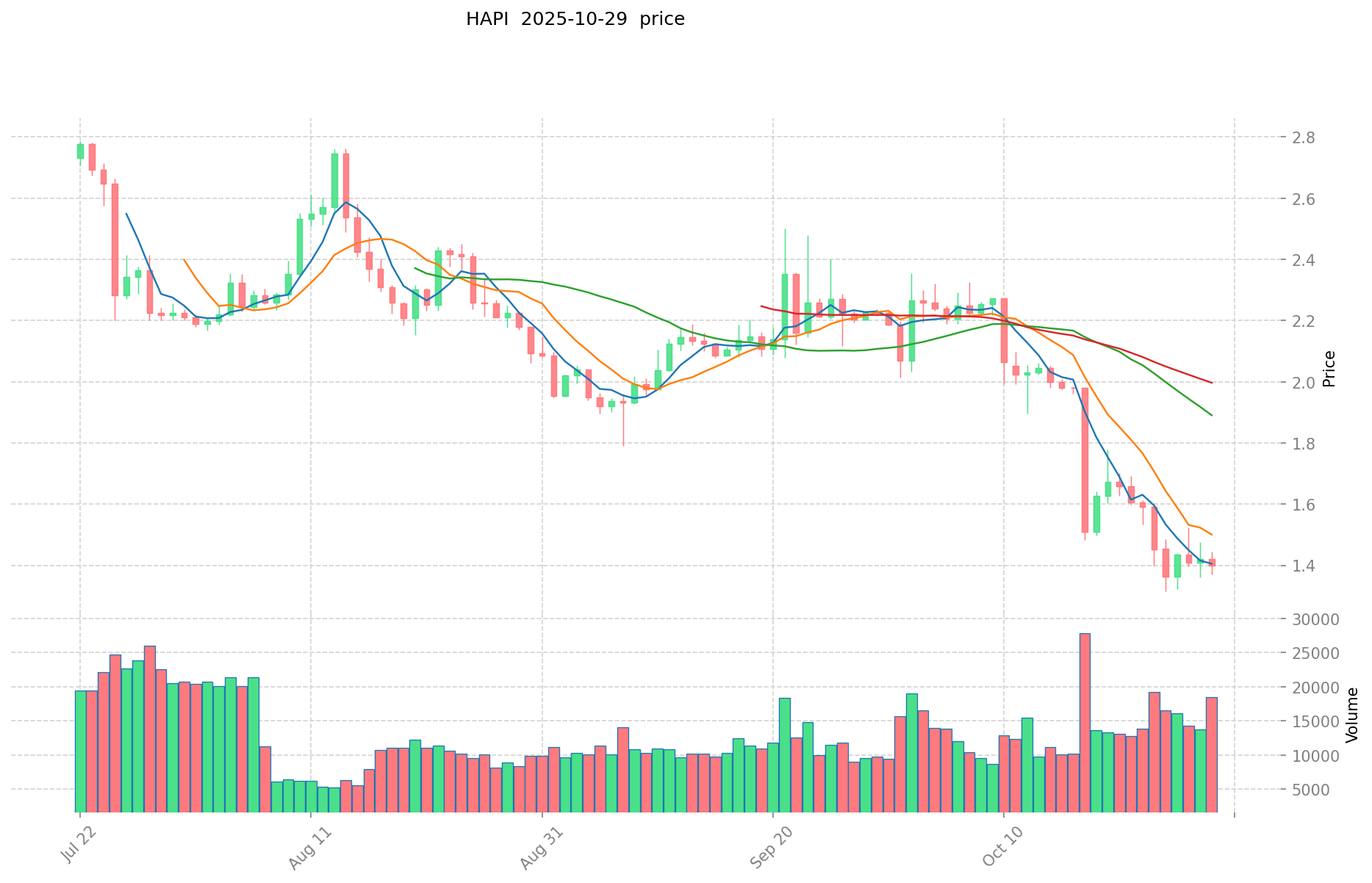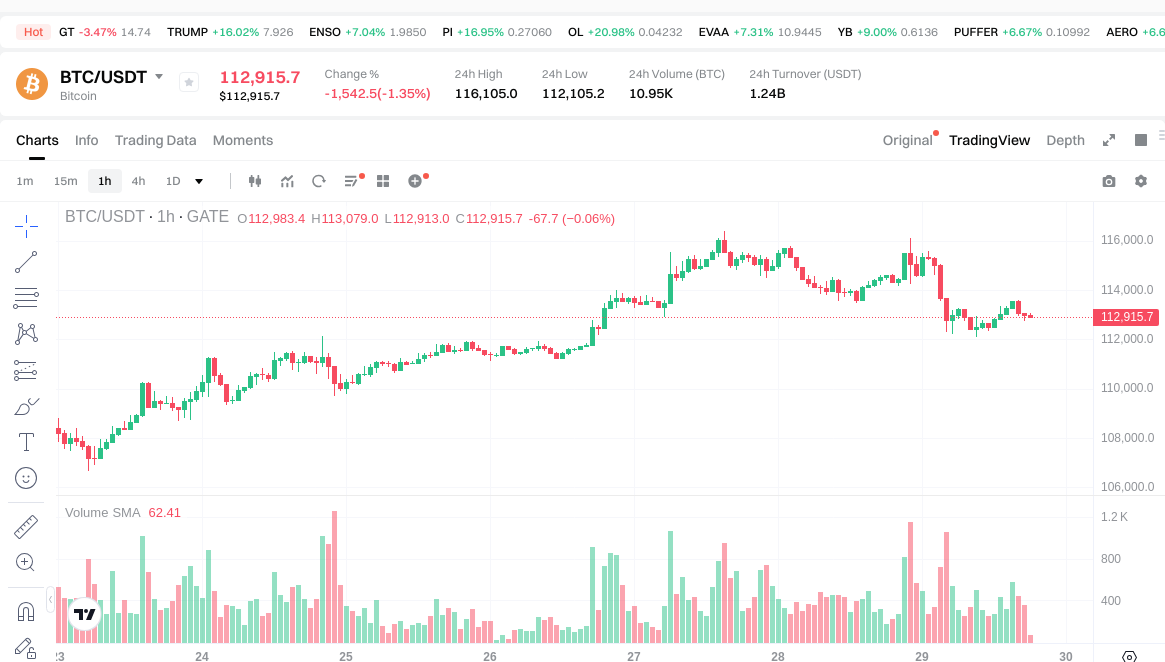HAPI vs BTC: The Battle for Cryptocurrency Dominance in the Digital Age
Introduction: HAPI vs BTC Investment Comparison
In the cryptocurrency market, HAPI vs BTC comparison remains an unavoidable topic for investors. The two not only differ significantly in market cap ranking, application scenarios, and price performance, but also represent different cryptocurrency asset positions.
HAPI (HAPI): Since its launch in 2021, it has gained market recognition for its cross-chain smart contracts enhancing DeFi security.
Bitcoin (BTC): Since its inception in 2008, it has been hailed as "digital gold" and is one of the cryptocurrencies with the highest global trading volume and market capitalization.
This article will provide a comprehensive analysis of the investment value comparison between HAPI and BTC, focusing on historical price trends, supply mechanisms, institutional adoption, technological ecosystems, and future predictions, attempting to answer the question investors care about most:
"Which is the better buy right now?" I. Price History Comparison and Current Market Status
HAPI and Bitcoin (BTC) Historical Price Trends
- 2021: HAPI reached its all-time high of $200.39, likely due to the overall crypto market bull run.
- 2020: Bitcoin experienced significant volatility, dropping to $3,850 in March due to the COVID-19 pandemic, before recovering and starting a bull run.
- Comparative analysis: During the 2021 bull market, HAPI rose from its launch price to its all-time high, while Bitcoin surged from around $10,000 to nearly $65,000.
Current Market Situation (October 29, 2025)
- HAPI current price: $1.363
- Bitcoin current price: $113,076.1
- 24-hour trading volume: HAPI $30,761.67 vs BTC $1,244,986,046.40
- Market sentiment index (Fear & Greed Index): 51 (Neutral)
Click to view real-time prices:
- View HAPI current price Market Price
- View BTC current price Market Price


Core Factors Influencing HAPI vs BTC Investment Value
Supply Mechanism Comparison (Tokenomics)
- Bitcoin: Fixed supply cap of 21 million coins with halving mechanism, creating natural scarcity and anti-inflationary properties
- HAPI: Limited information on specific tokenomics, likely follows platform-specific distribution model tied to ecosystem participation
- 📌 Historical pattern: Bitcoin's supply constraints have historically driven cyclical price movements, particularly around halving events
Institutional Adoption and Market Applications
- Institutional holdings: Bitcoin has gained significant institutional investment as a store of value and inflation hedge
- Enterprise adoption: Bitcoin increasingly used in cross-border payments, treasury reserves, and portfolio diversification, while HAPI adoption depends on its specific security platform utility
- Regulatory attitudes: Bitcoin faces varied but increasingly accepting regulatory frameworks globally, while HAPI's regulatory position is less established
Technical Development and Ecosystem Building
- Bitcoin technical upgrades: Layer-2 solutions like Lightning Network and innovations such as Ordinals/BRC-20 expanding utility
- HAPI technical development: Focus on blockchain security infrastructure and cross-chain security solutions
- Ecosystem comparison: Bitcoin has extensive payment infrastructure and growing DeFi applications, while HAPI's ecosystem is centered around security protocols for DeFi platforms
Macroeconomic Factors and Market Cycles
- Inflation resistance: Bitcoin widely recognized as a potential hedge against inflation due to fixed supply, while HAPI's properties in this regard are unproven
- Monetary policy impact: Interest rates and dollar strength affect Bitcoin as a risk asset, potentially impacting HAPI similarly but with different magnitude
- Geopolitical factors: Bitcoin benefits from global censorship resistance and cross-border transfer utility, HAPI's value proposition more focused on specialized security use cases
III. 2025-2030 Price Prediction: HAPI vs BTC
Short-term Prediction (2025)
- HAPI: Conservative $0.91857 - $1.371 | Optimistic $1.371 - $1.48068
- BTC: Conservative $81,332.712 - $112,962.1 | Optimistic $112,962.1 - $143,461.867
Mid-term Prediction (2027)
- HAPI may enter a growth phase, with an estimated price range of $1.215956352 - $1.764619584
- BTC may enter a bull market, with an estimated price range of $145,225.71371045 - $208,568.844158625
- Key drivers: Institutional inflows, ETF approvals, ecosystem development
Long-term Prediction (2030)
- HAPI: Base scenario $2.4262021577664 - $3.348158977717632 | Optimistic scenario $3.348158977717632+
- BTC: Base scenario $201,065.000632118025 - $221,171.5006953298275 | Optimistic scenario $221,171.5006953298275+
HAPI:
| 年份 | 预测最高价 | 预测平均价格 | 预测最低价 | 涨跌幅 |
|---|---|---|---|---|
| 2025 | 1.48068 | 1.371 | 0.91857 | 0 |
| 2026 | 1.5399072 | 1.42584 | 0.8840208 | 4 |
| 2027 | 1.764619584 | 1.4828736 | 1.215956352 | 8 |
| 2028 | 2.28948269472 | 1.623746592 | 0.99048542112 | 19 |
| 2029 | 2.8957896721728 | 1.95661464336 | 1.7805193254576 | 43 |
| 2030 | 3.348158977717632 | 2.4262021577664 | 1.310149165193856 | 78 |
BTC:
| 年份 | 预测最高价 | 预测平均价格 | 预测最低价 | 涨跌幅 |
|---|---|---|---|---|
| 2025 | 143461.867 | 112962.1 | 81332.712 | 0 |
| 2026 | 180778.896735 | 128211.9835 | 66670.23142 | 13 |
| 2027 | 208568.844158625 | 154495.4401175 | 145225.71371045 | 36 |
| 2028 | 205131.320616010625 | 181532.1421380625 | 168824.892188398125 | 60 |
| 2029 | 208798.2698871994875 | 193331.7313770365625 | 148865.433160318153125 | 70 |
| 2030 | 221171.5006953298275 | 201065.000632118025 | 112596.400353986094 | 77 |
IV. Investment Strategy Comparison: HAPI vs BTC
Long-term vs Short-term Investment Strategies
- HAPI: Suitable for investors focused on DeFi security solutions and ecosystem growth potential
- BTC: Suitable for investors seeking stability, inflation hedge, and long-term store of value
Risk Management and Asset Allocation
- Conservative investors: HAPI: 5% vs BTC: 95%
- Aggressive investors: HAPI: 20% vs BTC: 80%
- Hedging tools: Stablecoin allocation, options, cross-currency portfolio diversification
V. Potential Risk Comparison
Market Risk
- HAPI: Higher volatility due to lower market cap and trading volume
- BTC: Susceptible to macroeconomic factors and regulatory news
Technical Risk
- HAPI: Scalability, network stability, and potential security vulnerabilities
- BTC: Mining centralization, potential 51% attacks
Regulatory Risk
- Global regulatory policies may have differing impacts on both assets, with BTC facing more scrutiny but also more established frameworks
VI. Conclusion: Which Is the Better Buy?
📌 Investment Value Summary:
- HAPI advantages: Specialized focus on DeFi security, potential for high growth in a niche market
- BTC advantages: Established market leader, widespread adoption, strong network effect, and proven track record as a store of value
✅ Investment Advice:
- New investors: Consider allocating a majority to BTC for stability, with a small position in HAPI for potential growth
- Experienced investors: Balanced approach with BTC as a core holding and HAPI as a higher-risk, higher-reward component
- Institutional investors: Focus on BTC for its established market presence and regulatory clarity, with potential small allocation to HAPI for diversification
⚠️ Risk Warning: The cryptocurrency market is highly volatile. This article does not constitute investment advice. None
VII. FAQ
Q1: What are the main differences between HAPI and Bitcoin (BTC)? A: HAPI is a newer cryptocurrency focused on DeFi security solutions, while Bitcoin is the oldest and most established cryptocurrency, often seen as a store of value and "digital gold". BTC has a much larger market cap, higher trading volume, and wider institutional adoption compared to HAPI.
Q2: Which has shown better historical price performance? A: During the 2021 bull market, HAPI rose from its launch price to its all-time high of $200.39, while Bitcoin surged from around $10,000 to nearly $65,000. However, Bitcoin has a longer track record of price appreciation and cyclical movements.
Q3: How do their supply mechanisms differ? A: Bitcoin has a fixed supply cap of 21 million coins with a halving mechanism, creating scarcity. HAPI's specific tokenomics are less clear, but likely follow a platform-specific distribution model tied to ecosystem participation.
Q4: What are the key factors influencing their investment value? A: For Bitcoin: institutional adoption, use as an inflation hedge, regulatory developments, and technological upgrades. For HAPI: growth of DeFi security needs, ecosystem development, and adoption of its specific security solutions.
Q5: How do their 2030 price predictions compare? A: By 2030, HAPI's base scenario predicts a range of $2.43 - $3.35, with an optimistic scenario above $3.35. Bitcoin's base scenario for 2030 is $201,065 - $221,172, with an optimistic scenario above $221,172.
Q6: What are the recommended investment strategies for each? A: For HAPI, it's suitable for investors focused on DeFi security solutions and high growth potential. For Bitcoin, it's recommended for those seeking stability, inflation hedging, and long-term value storage. Conservative investors might allocate 5% to HAPI and 95% to BTC, while aggressive investors might consider 20% HAPI and 80% BTC.
Q7: What are the main risks associated with each cryptocurrency? A: HAPI faces higher volatility due to lower market cap and trading volume, as well as potential technical risks related to scalability and security. Bitcoin is susceptible to macroeconomic factors, regulatory news, and potential mining centralization issues.
Share
Content